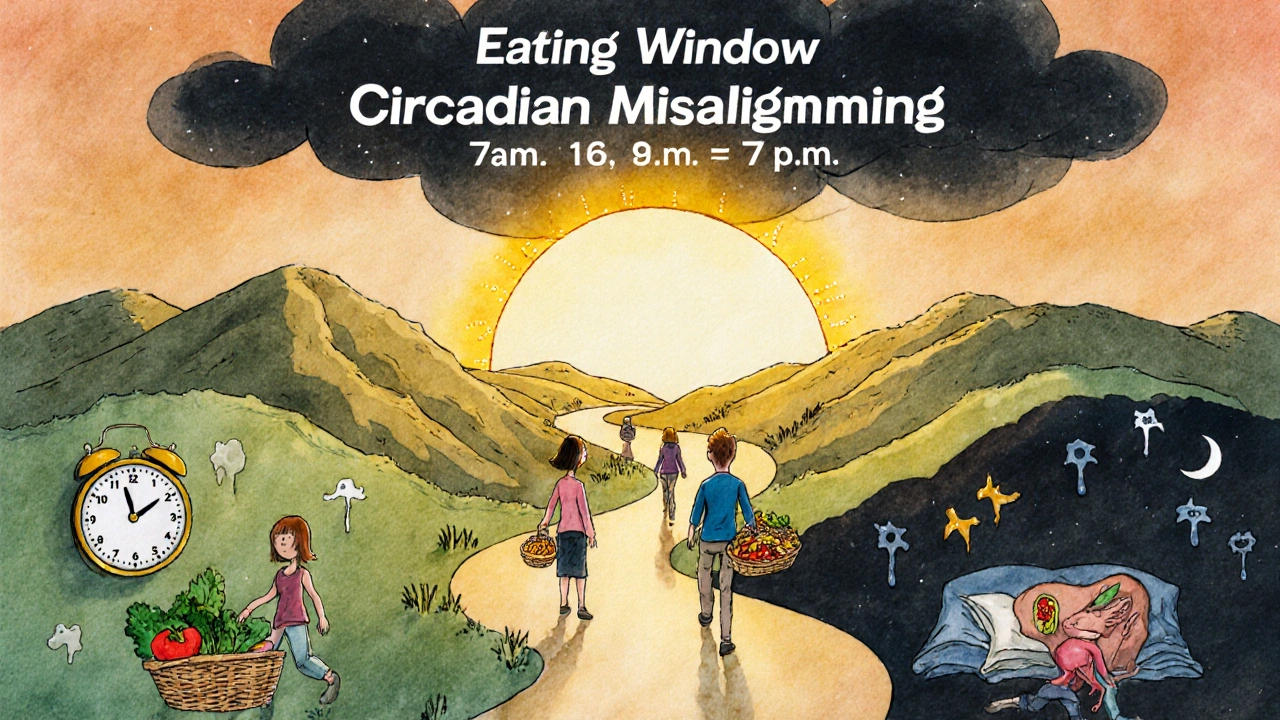
Ever wonder why you can eat the same amount and still gain weight - especially if you work nights or scroll past midnight? It’s not just about calories in, calories out. Your body’s internal clock, called the circadian rhythm, plays a bigger role in weight than most people realize. This 24-hour biological system controls when you feel sleepy, when your body burns fuel, and even when you crave snacks. When it’s out of sync - thanks to late nights, shift work, or constant screen light - your metabolism gets thrown off in ways that make losing weight feel impossible.
Why Your Body Burns Less When You Sleep Wrong
Your circadian rhythm isn’t just about sleep. It’s the conductor of your entire metabolic orchestra. Every organ - liver, fat tissue, pancreas - has its own clock that syncs with the master clock in your brain. When you eat or sleep at the wrong time, those clocks get out of tune. The result? Your body burns fewer calories, even if you’re doing everything else right. A 2014 study in PNAS tracked healthy adults on simulated night shifts. On night shift days, their total daily energy expenditure dropped by 3% - about 55 calories. That might sound small, but over a year, that’s the equivalent of gaining nearly 8 pounds without eating more. Even worse, when they tried to sleep during the day, their bodies burned 12-16% fewer calories than normal. That’s not because they were lazy - it’s because their metabolism had shifted into low gear, expecting nighttime rest, not daytime sleep. And it’s not just about movement. The thermic effect of food - the energy your body uses to digest meals - drops by 17% when you eat dinner late. So if you’re snacking at 1 a.m., your body isn’t just storing fat; it’s also failing to burn off what you just ate.Why You Crave Carbs at 2 a.m.
Sleep deprivation doesn’t just make you tired. It rewires your brain’s reward system. A University of Chicago study found that when people slept only 4 hours a night for four nights, their appetite jumped 22%. But the real kicker? Their craving for high-carb, high-sugar foods spiked by 33%. Brain scans showed their reward centers lit up like Christmas trees when they saw images of cookies and pizza. This isn’t weakness. It’s biology. When you’re sleep-deprived, your body produces more ghrelin - the hunger hormone - and less leptin - the fullness signal. Your brain starts treating food like a survival tool. Late-night snacks aren’t a habit; they’re a biological emergency response. Shift workers know this all too well. On Reddit’s r/ShiftWork forum, 78% of 1,245 respondents reported gaining weight after starting night shifts. One nurse wrote: “I gained 35 pounds in my first year. I ate the same food. But at 3 a.m., my body screamed for carbs - and I gave in.”Time-Restricted Eating: The Simple Fix
The good news? You don’t need to starve yourself or join a gym to fix this. You just need to eat within a tighter window - and stick to daylight hours. Research from the Salk Institute showed that overweight adults who ate all their meals within an 8-10 hour window during the day lost 3-5% of their body weight in just 12 weeks. That’s not magic. It’s alignment. When you eat only when your body expects food - between sunrise and sunset - your metabolism works the way it was designed to. The best window? For most people, it’s 7 a.m. to 7 p.m. But it depends on your chronotype. Morning people (early risers) do better with an 8 a.m. to 6 p.m. window. Night owls can shift it to 10 a.m. to 8 p.m. and still see results. A 2022 survey of 450 users on the Zero app found that those who ate only during daylight hours lost 3.2 kg (7.1 lbs) more over 12 weeks than those who ate whenever they wanted. And 74% said their nighttime cravings disappeared.
Why It’s Hard - and How to Stick With It
This sounds simple. But it’s not easy. Social life, family dinners, late work calls - they all fight against your rhythm. A 2021 study found that 68% of people trying time-restricted eating gave up because of dinner plans. Here’s how to make it stick:- Start slow. Narrow your eating window by 30-60 minutes each week. Don’t jump from 12 hours to 6.
- Keep sleep and wake times consistent - even on weekends. A 30-minute shift is enough to throw off your rhythm.
- Get morning sunlight. Step outside for 10-15 minutes within 30 minutes of waking. This resets your master clock.
- Avoid bright screens after 9 p.m. Blue light blocks melatonin and tricks your body into thinking it’s still daytime.
- Don’t eat within 3 hours of bed. Even a light snack can delay your body’s shift into fat-burning mode.
What Experts Say - And What They Disagree On
Dr. Frank Scheer from Brigham and Women’s Hospital says circadian misalignment is “as metabolically disruptive as eating an extra 300 calories a day.” His team found shift workers gained 2.5 kg more than day workers - even when eating the same amount. But not everyone agrees. Dr. Michael Schwartz from the University of Washington points out that the 55-calorie daily energy drop might be too small to matter on its own. He argues that sleep disruption is just one piece of a bigger puzzle - and not the biggest one. Here’s the truth: it doesn’t have to be either/or. Circadian rhythm isn’t the only cause of weight gain. But it’s a silent driver that makes everything else harder. Fix your sleep and eating schedule, and suddenly, dieting becomes easier. Exercise feels less like a chore. Your energy stays steady. The Endocrine Society’s 2019 review concluded that circadian disruption adds 5-10% to obesity risk in shift workers - independent of diet and activity. That’s not nothing. That’s the difference between losing 5 pounds and losing 10.
The Bigger Picture: Why This Matters Now
More than 20% of the global workforce works nights or rotating shifts. That’s over 700 million people whose bodies are fighting against their clocks. In Australia, where 24/7 service jobs are growing, this isn’t a niche issue - it’s a public health trend. Health systems are starting to act. Kaiser Permanente’s pilot program for night shift workers cut weight gain by 42% just by adjusting light exposure and meal timing. The FDA now requires drug trials for obesity to track how timing affects results. Wearables like Fitbit now include a “circadian alignment score” that predicts 18% of weight change variability. This isn’t a fad. It’s physiology. Your body didn’t evolve to eat pizza at midnight and sleep at noon. When you align your eating and sleeping with the sun, you’re not just losing weight - you’re letting your body work the way it was meant to.What to Do Tomorrow
You don’t need to overhaul your life. Start with one change:- Move your last meal to 7 p.m. - no exceptions.
- Get 10 minutes of sunlight before 9 a.m.
- Turn off screens an hour before bed.
Can poor sleep cause weight gain even if I eat healthy?
Yes. Even if you eat clean, lack of sleep increases hunger hormones and reduces your body’s ability to burn calories efficiently. Studies show sleep-deprived people consume over 250 extra calories daily - mostly from carbs and fats - without realizing it. Your metabolism slows down at night, so late meals get stored as fat instead of burned.
Is time-restricted eating the same as intermittent fasting?
They’re similar, but not the same. Intermittent fasting focuses on how long you fast - like 16:8. Time-restricted eating (TRE) focuses on when you eat - ideally during daylight hours. TRE aligns with your circadian rhythm, which makes it more effective for metabolism. Eating your last meal at 8 p.m. is better than eating it at midnight, even if both are within an 8-hour window.
Do I need to track my sleep to lose weight?
Not necessarily. But if you’re struggling to lose weight despite eating well and exercising, tracking your sleep schedule can reveal hidden patterns. Are you sleeping late on weekends? Do you eat after 9 p.m.? These small shifts can sabotage your progress. A simple sleep log - noting when you get in bed and wake up - is enough to spot problems.
Can shift workers lose weight with circadian rhythm fixes?
Absolutely - but it takes strategy. Shift workers should aim for consistent sleep times even on days off. Eat meals during active hours (even if that’s 2 a.m. to 10 a.m.), avoid bright light before sleep, and use blackout curtains. Studies show shift workers who follow daylight-aligned eating lose more weight than those who don’t, even on night shifts. The key is consistency, not timing relative to the sun.
How long until I see results from fixing my sleep and eating schedule?
Most people notice less nighttime hunger and better sleep within 3-5 days. Weight loss typically starts after 2-4 weeks. In studies, people lost 3-5% of body weight in 12 weeks. That’s 3-7 pounds for someone who weighs 150 pounds. The biggest wins aren’t always on the scale - it’s more energy, fewer cravings, and better sleep.






Jim Oliver
November 8, 2025 AT 05:08Let me get this straight-you’re telling me I gained 8 lbs/year just because I ate at midnight? Wow. My metabolism must be a broken toaster. Meanwhile, my 70-year-old grandma who eats fried chicken at 2 a.m. and sleeps till noon is still running marathons. Coincidence? I think not.
William Priest
November 8, 2025 AT 23:39ok so i read this whole thing and like… the real issue is we’re all just lazy and blame biology. my body dont care if its 2am, if i’m hungry i eat. also why is everyone so obsessed with ‘aligning with the sun’? i live in a city, not a cabin in the woods. #realworld
Ryan Masuga
November 9, 2025 AT 15:27I’ve been doing 8am–6pm eating for 3 weeks now and honestly? My midnight cravings are GONE. I used to snack like a raccoon after midnight. Now I just feel… calm. Like my body finally trusts me. It’s not magic-it’s just listening. You guys should try it for 7 days. No pressure. Just observe how you feel.
Jennifer Bedrosian
November 10, 2025 AT 01:05I gained 40 pounds after my night shift job started and I cried every night because I felt so out of control. This post made me feel seen. Like… it’s not my fault. My body was screaming and I just kept feeding it. Now I’m trying to eat by 7pm and it’s hard but I’m proud of myself for even trying. Thank you for writing this
Lashonda Rene
November 10, 2025 AT 01:46You know what I realized? I always thought it was just about willpower but it’s actually like your body has a schedule and when you mess with it it gets confused. Like your liver is like hey it’s 3am why are you feeding me? And it just shuts down. And then you feel tired and eat more and it’s a cycle. I didn’t know it was that complicated but now I get it. I’m gonna try to eat earlier and see what happens. No promises but I’m hopeful
Andy Slack
November 11, 2025 AT 20:13Just got back from my 11pm–7am shift. I’m eating my last meal at 8pm now. It’s weird. I’m not hungry at 3am anymore. I just… sleep. And I’m not even trying. It’s like my body finally got the memo. This is the first time in years I’ve woken up without craving sugar. Mind blown.
Rashmi Mohapatra
November 13, 2025 AT 07:51Everyone in India knows this. We’ve been eating dinner before sunset for 5000 years. Your body isn’t broken. You just forgot how to live. Stop overthinking. Eat early. Sleep dark. Move. Done.
Abigail Chrisma
November 13, 2025 AT 15:25As someone who grew up in a household where dinner was always at 6:30pm and screens were off by 9, I never struggled with weight. I didn’t know it was ‘circadian rhythm’-I just thought it was how things were done. Maybe the answer isn’t new science-it’s returning to old rhythms. Thank you for reminding us of that.
Ankit Yadav
November 14, 2025 AT 00:37Shift workers need support systems not just advice. My cousin works nights and eats at 3am because that’s when the family is awake. If you want people to change, you have to change the environment too. Not just tell them to eat earlier when everyone else is eating at midnight.
Meghan Rose
November 14, 2025 AT 20:19Okay but what if you’re a night owl? Like, my body naturally wakes up at 1pm? Why should I force myself to eat at 7am when I’m still asleep? This feels like another wellness trend that ignores neurodiversity. You’re not helping. You’re just shaming people for being different.
Steve Phillips
November 16, 2025 AT 05:11Oh, so now it’s the circadian rhythm’s fault? Not the 3000-calorie keto pizza I ate at 1 a.m.? Not the 12 energy drinks? Not the fact that I haven’t moved since 2018? Let me guess-the algorithm is to blame too? This is the most performative pseudoscience I’ve read since ‘detox tea fixes everything’.
Rachel Puno
November 17, 2025 AT 08:16Starting with one change is everything. I did the 7pm meal rule for a week and didn’t even think about snacks after. It was like my brain got a new setting. You don’t need to do everything at once. Just pick one. Do it. Then see what happens. You’ve got this.
Clyde Verdin Jr
November 19, 2025 AT 04:24So… the real villain is the sun? I’m supposed to bow down to daylight like some kind of pagan? What if I live in Alaska? Or work in a basement? Or my kid wakes up at 4am? This isn’t science-it’s a cult. 🙄
Key Davis
November 19, 2025 AT 06:57While the concept of circadian alignment is biologically sound, the application of time-restricted eating must be contextualized within socioeconomic realities. For many, meal timing is dictated by labor schedules, childcare responsibilities, and food accessibility-not personal preference. A one-size-fits-all recommendation risks exacerbating health inequities.
Cris Ceceris
November 19, 2025 AT 19:02What if the real question isn’t how to fix our clocks-but why our society expects us to live against them? We’re not broken. The system is. Why do we think it’s normal to work nights, eat alone at 2am, and then blame our bodies for not being ‘perfect’? Maybe we need to change the world, not just our meals.